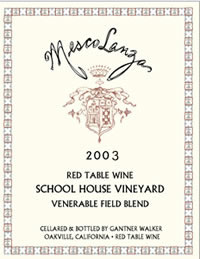 |
|
Wine Details
Price:
$35.00 per bottle
Description:
Mescolanza is a Spanish word for "medeley". This venerable—some of the vines are well over 100 years old—mixed black field-blend derives its character from mountain-grown Zinfandel (76%), Petite Sirah (17%) and Carignane (7%) varieties. The unirrigated vineyard block bears a fraction of the amount of fruit which its irrigated cousins produce. Thus the elegant, spicy wine from this fruit is more intense and concentrated. It is a ‘big’ wine with balanced acidity which makes a robust wine that is a perfect paring with rich, well-flavored foods. This 2003 Mescolanza was fermented in open bins and matured through its secondary malolactic fermentation in older, seasoned barrels providing an ever so subtle kiss of oak.
We have chosen to show the Vallejo Family Crest on the Mescolanza label, because John is the great great grandson of Salvador Vallejo, the first European resident of the Napa Valley. John cautions, "Excessive consumption of this wine may cause Zinfomania".
.
|
|
Varietal Definition
Zinfandel:
Zinfandel is a variety of red grape planted in over 10 percent of California wine vineyards. DNA fingerprinting revealed that it is genetically equivalent to the Croatian grape Crljenak Kaštelanski, and also the Primitivo variety traditionally grown in the 'heel' of Italy. It is typically made into a robust red wine. Its taste depends on the ripeness of the grapes from which it is made. Red berry fruits like raspberry predominate in wines from cooler areas such as the Napa Valley, whereas blackberry, anise and pepper notes are more common in wines made in warmer areas such as Sonoma County. Many Zinfandels come from head pruned ‘Old Vines’. ‘Old Vine’ is generally understood to mean a vine that is more than 50 years old and that produces less than three tons per acre. ‘Head Pruning’ is an old European style of pruning that trains the vine into the shape of a goblet. It requires no wires or other complex trellis systems. Head pruning spreads the fruit uniformly along the vine and allows light penetration.In the USA a semi-sweet Rosé (blush-style) wine called ‘White Zinfandel’ has achieved widespread popularity. In fact, this popularity has so outstripped all other forms that many fans think there is actually a grape called “White Zinfandel” (there isn’t)!
|
Petite Sirah:
Petite Sirah is the same as the French variety known as Durif, a cross of Peloursin, with the true Syrah. A French nurseryman, Dr. François Durif, propagated the grape trying for resistance to powdery mildew and named it after himself, in the 1870s. Petite Sirah has long been an important blending grape, prized primarily for its deep color and fairly intense tannin. It is the variety most often chosen to blend into Zinfandel for added color, complexity, body, and to tone down the tendency of Zins toward "jammy" fruit.
|
Carignane:
Carignane is one of the world’s most prolific wine varieties. Thriving in warm climates, Carignane was until the late 1970s, the most widely-planted red variety in California. Hailing from Aragon, Spain, this grape is capable of deeply-colored, extracted and tannic wines of considerable alcohol. It is a late-budder and does not ripen until late in the season. Highly prone to mildew disease, it requires long, dry growing conditions. It is often used as a blending component with other, more anemic, hot-climate varieties, like Grenache and Cinsault, which typically lack the deep pigment and extract which Carignane brings to the blend.
|
|